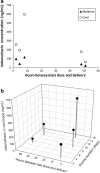Pharmacokinetics of indomethacin in pregnancy
- PMID: 24493205
- PMCID: PMC4164383
- DOI: 10.1007/s40262-014-0133-6
Pharmacokinetics of indomethacin in pregnancy
Abstract
Background and objectives: Although indomethacin has been widely used for the treatment of preterm labor over the past 40 years, there are few reports regarding its pharmacokinetics in pregnant women.
Methods: This opportunistic study assessed the steady-state pharmacokinetics of indomethacin in pregnant subjects to whom an oral dose of 25 mg every 6 h was prescribed. Indomethacin concentrations in plasma and urine were analyzed by a validated high-performance liquid chromatography method with mass spectrometric detection.
Results: The mean area under the plasma concentration versus time curve at steady state (AUCss) was 1.91 ± 0.53 μg·h/mL, mean peak plasma concentration (C max) was 1.02 ± 0.49 μg/mL, and mean time to reach C max (t max) was 1.3 ± 0.7 h. The mean apparent clearance at steady state was 14.5 ± 5.5 L/h, which is higher than the apparent clearance reported in the literature for non-pregnant subjects. Indomethacin crosses the placenta; the mean fetal/maternal ratio from five sets of cord blood samples collected at delivery was 4.0 ± 1.1.
Conclusions: Further studies are needed to determine whether any dose adjustments are necessary as a result of the increased clearance of indomethacin during pregnancy.
Figures


Similar articles
-
Indomethacin Pharmacokinetics and Pharmacodynamics in Pregnancies With Preterm Labor: The Need for Dose-Ranging Trials.J Clin Pharmacol. 2024 Jun;64(6):728-736. doi: 10.1002/jcph.2412. Epub 2024 Feb 5. J Clin Pharmacol. 2024. PMID: 38315120 Free PMC article.
-
Liposomes: a nanoscale drug carrying system to prevent indomethacin passage to the fetus in a pregnant mouse model.Am J Obstet Gynecol. 2015 Apr;212(4):508.e1-7. doi: 10.1016/j.ajog.2015.02.006. Epub 2015 Feb 13. Am J Obstet Gynecol. 2015. PMID: 25683966
-
Placental transfer of sulindac, sulindac sulfide, and indomethacin in a human placental perfusion model.Am J Obstet Gynecol. 1999 Jan;180(1 Pt 1):174-80. doi: 10.1016/s0002-9378(99)70171-7. Am J Obstet Gynecol. 1999. PMID: 9914600
-
The controversy surrounding indomethacin for tocolysis.Am J Obstet Gynecol. 2001 Feb;184(3):264-72. doi: 10.1067/mob.2001.111718. Am J Obstet Gynecol. 2001. PMID: 11228471 Review.
-
Use of non-steroidal anti-inflammatory drugs in pregnancy: impact on the fetus and newborn.Curr Drug Metab. 2012 May 1;13(4):474-90. doi: 10.2174/138920012800166607. Curr Drug Metab. 2012. PMID: 22299823 Review.
Cited by
-
Effect of deuteration on the single dose pharmacokinetic properties and postoperative analgesic activity of methadone.Drug Metab Pharmacokinet. 2022 Dec;47:100477. doi: 10.1016/j.dmpk.2022.100477. Epub 2022 Oct 13. Drug Metab Pharmacokinet. 2022. PMID: 36368298 Free PMC article.
-
Effect of CYP2C9 Polymorphisms on the Pharmacokinetics of Indomethacin During Pregnancy.Eur J Drug Metab Pharmacokinet. 2019 Feb;44(1):83-89. doi: 10.1007/s13318-018-0505-7. Eur J Drug Metab Pharmacokinet. 2019. PMID: 30159654 Free PMC article.
-
Pharmacologic studies in vulnerable populations: Using the pediatric experience.Semin Perinatol. 2015 Nov;39(7):532-6. doi: 10.1053/j.semperi.2015.08.007. Epub 2015 Sep 8. Semin Perinatol. 2015. PMID: 26358805 Free PMC article. Review.
-
Inclusion of pregnant and breastfeeding women in research - efforts and initiatives.Br J Clin Pharmacol. 2018 Feb;84(2):215-222. doi: 10.1111/bcp.13438. Epub 2017 Oct 22. Br J Clin Pharmacol. 2018. PMID: 28925019 Free PMC article. Review.
-
Development of Physiologically Based Pharmacokinetic/Pharmacodynamic Model for Indomethacin Disposition in Pregnancy.PLoS One. 2015 Oct 2;10(10):e0139762. doi: 10.1371/journal.pone.0139762. eCollection 2015. PLoS One. 2015. PMID: 26431339 Free PMC article.
References
-
- Gamissans O, Balasch J. Prostaglandin synthetase inhibitors in the treatment of preterm birth. In: Fuchs A-R, Stubblefield PG, Fuchs F, editors. Preterm birth: causes, prevention, and management. 2nd ed. McGraw-Hill; New York: 1993. pp. 309–32.
-
- Zuckerman H, Shalev E, Gilad G, et al. Further study of the inhibition of premature labor by indomethacin. Part II: double-blind study. J Perinatal Med. 1984;12:25–9. - PubMed
-
- Zuckerman H, Reiss U, Rubinstein I. Inhibition of human premature labor by indomethacin. Obst Gynecol. 1974;44:787–92. - PubMed
-
- Wiqvist N. Endogenous prostaglandins in normal pregnancy and labor. Pharmacol Ther B. 1975;1:297–310. - PubMed
-
- Rane A, Oelz O, Frolich JC, et al. Relation between plasma concentration of indomethacin and its effect on prostaglandin synthesis and platelet aggregation in man. Clin Pharmacol Ther. 1978;23:658–68. - PubMed
Publication types
MeSH terms
Substances
Grants and funding
LinkOut - more resources
Full Text Sources
Other Literature Sources
Miscellaneous

